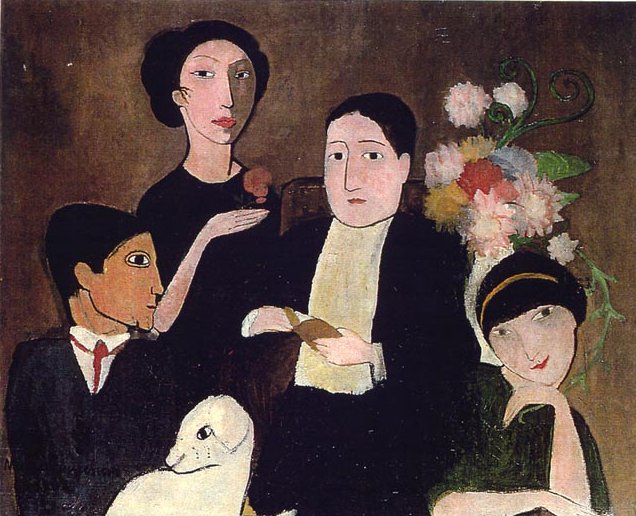 Les Saltimbanques (The Acrobats), Pablo Picasso, 1905
Les Saltimbanques (The Acrobats), Pablo Picasso, 1905
The Fifth Elegy is largely inspired by this Pablo Picasso‘s Rose Period painting, in which Picasso depicts six figures pictured “in the middle of a desert landscape and it is impossible to say whether they are arriving or departing, beginning or ending their performance.” Rilke depicted the six artists about to begin their performance, and that they were used as a symbol of “human activity … always travelling and with no fixed abode, they are even a shade more fleeting than the rest of us, whose fleetingness was lamented.” Further, Rilke in the poem described these figures as standing on a “threadbare carpet” to suggest “the ultimate loneliness and isolation of Man in this incomprehensible world, practicing their profession from childhood to death as playthings of an unknown will … before their ‘pure too-little’ had passed into ’empty too-much.'”
FIFTH DUINO ELEGY
For Frau Hertha Koenig
Who are these rambling acrobats,
less secure than even we;
twisted since childhood
(for benefit of whom?)
by an unappeasable will?
A will which wrings, bends,
swings, twists and catapults,
catching them when they fall
through slick and polished air
to a threadbare carpet worn
ever thinner by their leaping:
lost carpet of the great beyond,
stuck like a bandage to an earth
bruised by suburban skies.
Ensemble,
their bodies trace a vague
capital “C” for Creation…
captured by an inevitable grip
which bends even the mightiest,
as King Augustus the Strong
folded a pewter plate for laughs.
Around this center
the Rose of Looking
blossoms and sheds.
Around this pounding pestle,
this self pollinating pistle
producing petals of ennui,
blooms of customary apathy
speciously shine with
superfluous smiles.
There: the wrinkled, dried up Samson,
becomes, in old age, a drummer-
too small for the skin which looks
as though it once held two of him.
The other must be dead and buried
while this half fares alone,
deaf and somewhat addled
within the widowed skin.
There: the young man who seems
the very offspring of a union
between a stiff neck and a nun,
braced and buckled,
full of strength and
innocent simplicity.
O, you, children,
delivered to the infant Pain
as a toy to amuse it,
during some extended
illness of its childhood.
You, boy, discover
a hundred times a day
what green apples know,
dropping off a tree created
through mutual interactions
(coursing through spring,
summer and, swift as water,
fall, all in a flash)
to bounce, thud, upon the grave.
Sometimes, in fleeting glances
toward your seldom tender mother,
affection almost surfaces,
only to submerge as suddenly
beneath your face…a shy,
half-tried expression…
and then the man claps,
commanding you to leap again
and before any pain can
straddle your galloping heart,
your stinging soles outrace it,
chasing a brief pair of
actual tears to your eyes,
still blindly smiling.
O angel, pluck that
small flower of healing!
Craft a vessel to contain it!
Set it amongst joys not
yet vouchsafed us.
Upon that fair herbal jar,
in flowing, fancy letters,
inscribe: “Subrisio Saltat.”
…Smile of Acrobat…
And you, little sweetheart,
silently overslept by
the most exciting joys-
perhaps your skirthems
are happy in your stead,
or maybe the green metallic silk,
stretched tight by budding breasts,
feels itself sufficiently indulged.
You,
displaying, for all to see,
the fruit which tips the
swaying scales of balance,
suspended from the shoulders.
Where…O where is that place,
held in my heart, before they’d
all achieved such expertise,
were apt still to tumble asunder
like poorly fitted animals mating…
where the barbell still seems heavy,
where the discus wobbles and topples
from a badly twirled baton?
Then: Presto! in this
exasperating nowhere:
the unspeakable space appears where
purity of insufficiency transforms
into overly efficient emptiness.
Where the monumental bill of charges,
in final arbitration, totals zero.
Plazas, O plazas of Paris,
endless showcase, where
Madame Death the Milliner
twists and twines the
ribbons of restlessness,
designing ever new frills,
bows, rustles and brocades,
dyed in truthless colors,
to deck the trashy
winter hats of fate.
Angel! Were there an unknown place
where, upon an uncanny carpet, lovers
could disport themselves in ways
here inconceivable-daring ariel maneuvers
of the heart, scaling high plateaus of passion,
ladders leaning one against the other,
planted trembling upon the void…
Were there such a place, would their
performance prove convincing to an audience
of the innumerable and silent dead?
Would not these dead toss down their
final, hoarded, secret coins of joy,
legal tender of eternity, before the
couple smiling on that detumescent carpet,
fully satisfied?
Rainer Maria Rilke
Translated by Robert Hunter
 Minotauromachy, Pablo Picasso, 1935
Minotauromachy, Pablo Picasso, 1935







































